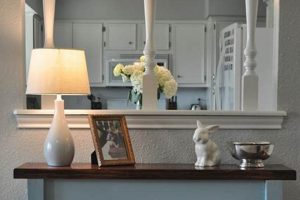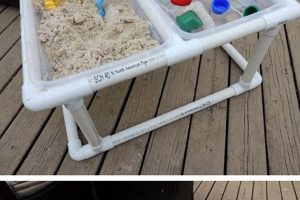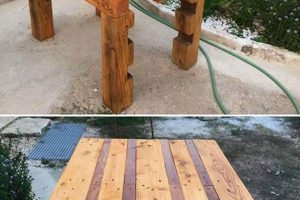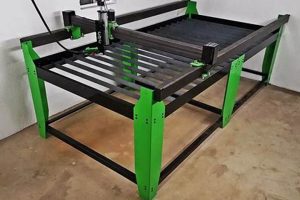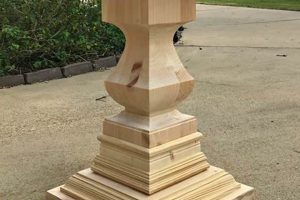The concept involves a horizontally oriented surface, typically situated near a bed, that is affixed to a wall without visible supports extending to the floor. This furniture arrangement provides a convenient location for personal items, such as books, lamps, or electronic devices. The construction of such a furnishing often relies on readily available materials and fundamental woodworking techniques.
This type of bedside surface offers space-saving advantages, particularly in smaller bedrooms, by eliminating the footprint of traditional furniture legs. Further, its inherent design versatility allows for customization to match diverse aesthetic preferences and existing room dcor. Historically, wall-mounted furniture solutions have been implemented to maximize space utilization and create a streamlined appearance.
The subsequent sections will delve into the selection of appropriate materials, detail the necessary tools and safety precautions, provide step-by-step construction methods, and explore various finishing options to achieve a personalized and functional bedside storage solution.
Essential Guidance for a Wall-Mounted Bedside Surface
The following recommendations are intended to optimize the design and construction of a bedside surface attached directly to the wall. These guidelines prioritize structural integrity, aesthetic appeal, and user convenience.
Tip 1: Material Selection. Prioritize high-quality wood or wood composites such as plywood or MDF. Ensure the chosen material is sufficiently thick to support anticipated weight without deflection. Consider the grain pattern and surface texture in relation to the desired aesthetic.
Tip 2: Weight Assessment. Accurately estimate the anticipated load the surface will bear. Incorporate a safety factor of at least 2 to account for unexpected increases in weight. This calculation will inform the selection of appropriate mounting hardware.
Tip 3: Mounting Hardware Selection. Employ heavy-duty brackets specifically designed for wall mounting. Ensure the brackets are compatible with the wall’s construction (e.g., drywall, plaster, concrete). Lag bolts and toggle bolts are often necessary for secure attachment to wall studs.
Tip 4: Stud Location. Precisely identify the location of wall studs using a stud finder. Mounting the surface directly to studs provides the most reliable support. If stud placement is unsuitable, utilize appropriate drywall anchors rated for the anticipated weight.
Tip 5: Leveling and Alignment. Prior to securing the surface, meticulously ensure it is perfectly level using a spirit level. Precise alignment is crucial for both aesthetics and functionality. Utilize shims as necessary to correct any imperfections.
Tip 6: Edge Treatment. Address the exposed edges of the material. Options include applying edge banding, routing a decorative profile, or applying multiple coats of sealant to prevent moisture damage and splintering. Consider the overall design aesthetic.
Tip 7: Cord Management. If the surface will accommodate electronic devices, incorporate provisions for cable management. This may involve drilling holes for cable routing or installing cable clips to keep cords organized and concealed.
These considerations will facilitate the creation of a robust, aesthetically pleasing, and practical bedside surface that effectively utilizes space and enhances the functionality of the bedroom environment.
The subsequent portion of this document addresses common pitfalls encountered during construction and offers solutions to ensure a successful outcome.
1. Material Selection
Material selection directly influences the structural integrity, longevity, and aesthetic appeal of a wall-mounted bedside surface. The choice dictates the weight-bearing capacity of the unit, its resistance to wear and tear, and its overall compatibility with the existing bedroom dcor. Inadequate material selection can lead to structural failure, premature degradation, or visual disharmony.
For example, utilizing particleboard without adequate reinforcement may result in sagging or collapse under load, particularly if subjected to moisture. Conversely, selecting a hardwood such as oak or maple offers superior strength and durability but may present challenges in terms of cost and workability. Plywood, a cost-effective compromise, provides a balance of strength and affordability. Surface treatments, such as veneers or paint, further impact the aesthetic and protective qualities of the bedside surface. The chosen finish should be resistant to scratches, stains, and fading to ensure long-term visual appeal.
In summary, the material selection process represents a critical juncture in the construction of a durable and aesthetically pleasing wall-mounted bedside surface. Thoughtful consideration of load requirements, environmental factors, and design preferences is essential. Ultimately, a well-informed material choice significantly contributes to the overall success and longevity of the project, ensuring both functionality and visual integration within the bedroom environment.
2. Weight Capacity
The weight capacity represents a fundamental design parameter in the construction of a wall-mounted bedside surface. It dictates the maximum load the structure can safely bear without risk of failure. Ignoring this factor during the planning and execution phases can result in structural instability, potentially causing the unit to detach from the wall, resulting in damage to property and posing a risk of injury. The weight capacity is determined by several interrelated factors, including the material properties, the mounting hardware employed, and the structural integrity of the wall to which it is affixed.
For example, consider a scenario where a bedside surface constructed from lightweight MDF is mounted to drywall using inadequate anchors. If the surface is then loaded with a heavy lamp, several books, and an alarm clock, the combined weight may exceed the load-bearing capacity of the anchors. This could lead to the anchors pulling out of the drywall, causing the surface to detach from the wall. Conversely, a surface constructed from solid hardwood and securely mounted to wall studs with lag bolts can safely support a significantly greater load. The choice of materials and mounting methods directly influences the weight capacity and overall safety of the installation. Real-world examples of bedside tables collapsing due to improper weight assessment or installation are prevalent and underscore the practical significance of this understanding.
In summary, a thorough assessment of the anticipated load and the selection of appropriate materials and mounting hardware are essential for ensuring the structural integrity and safety of a wall-mounted bedside surface. Accurate calculation of the required weight capacity, coupled with meticulous attention to installation details, mitigates the risk of failure and ensures the long-term functionality and safety of the unit. The absence of this critical consideration jeopardizes the stability and safety of the entire project.
3. Mounting Security
Mounting security is paramount in the construction of any wall-mounted structure, particularly in the case of a bedside surface. Its adequacy directly correlates with the safety, longevity, and functionality of the installation. Insufficient mounting security presents significant risks, including structural failure, property damage, and potential injury.
- Stud Engagement
Direct engagement with wall studs, the vertical structural members within a wall, offers the most robust mounting solution. Locating studs with precision, typically at 16-inch or 24-inch intervals, and securing the surface directly to them using appropriate fasteners (e.g., lag bolts) maximizes load-bearing capacity. Failure to engage studs necessitates the use of alternative anchoring methods, which inherently offer reduced load-bearing capabilities. In situations where stud alignment is unfavorable, reinforcement within the wall cavity may be required to provide adequate support.
- Anchor Selection
When stud engagement is not feasible, the selection of appropriate drywall anchors becomes critical. Different anchor types offer varying degrees of load-bearing capacity and suitability for different wall materials. Toggle bolts, expansion anchors, and self-drilling anchors represent common options, each with specific installation requirements and limitations. Overestimation of an anchor’s capacity or improper installation can result in anchor failure, leading to detachment of the bedside surface from the wall. It’s imperative to consult manufacturer specifications and adhere to recommended installation procedures.
- Bracket Design and Placement
The design and placement of mounting brackets contribute significantly to overall mounting security. Brackets should be constructed from durable materials with sufficient strength to support the anticipated load. Strategic bracket placement, maximizing contact area with both the wall and the surface, distributes the load effectively. The number of brackets required is directly proportional to the weight and dimensions of the surface. Inadequate bracket quantity or suboptimal placement can create stress concentrations, increasing the risk of failure at specific points.
- Fastener Quality and Installation
The quality of fasteners (e.g., screws, bolts) and their proper installation are indispensable for secure mounting. Fasteners must be compatible with both the mounting brackets and the wall material. Using screws that are too short or too thin compromises the strength of the connection. Overtightening fasteners can strip the threads, weakening the joint, while undertightening fails to provide adequate clamping force. Applying appropriate torque during installation, following manufacturer recommendations, ensures a secure and reliable connection.
These facets underscore the importance of a comprehensive approach to mounting security. Each element plays a crucial role in ensuring the stability and safety of a wall-mounted bedside surface. Neglecting any aspect of mounting security can compromise the entire installation, leading to potentially hazardous consequences. Diligent adherence to best practices in stud engagement, anchor selection, bracket design, and fastener installation is essential for a successful and durable outcome.
4. Space Optimization
A primary advantage of a wall-mounted bedside surface lies in its capacity to optimize spatial arrangements, particularly within compact bedroom environments. By eliminating the need for supporting legs or a bulky base, the furniture occupies a minimal footprint, liberating floor space for improved maneuverability and a less cluttered aesthetic. This characteristic is particularly beneficial in smaller bedrooms, where every square foot holds significant value.
The absence of floor-standing supports facilitates ease of cleaning and maintenance, as access beneath the surface is unimpeded. Further, the adjustable mounting height inherent in the design enables customization to individual preferences and bed frame heights, ensuring ergonomic accessibility. In contrast to traditional bedside tables, a wall-mounted variant provides increased flexibility in placement, allowing for installation in locations where conventional furniture might prove impractical. A typical urban apartment setting, where bedroom dimensions are often restricted, provides a tangible example of the functional benefits derived from such space-saving measures. The freed-up area can then be repurposed for other essential furnishings or simply to enhance the room’s overall sense of spaciousness.
Therefore, the integration of a wall-mounted bedside surface represents a deliberate strategy for maximizing usable space, streamlining cleaning routines, and customizing furniture placement within the bedroom. The inherent space-optimizing characteristics of this design contribute significantly to enhanced functionality and improved aesthetic appeal, rendering it a particularly suitable solution for space-constrained living environments. The benefits extend beyond mere space-saving, positively influencing the overall user experience and enhancing the perceived value of the living space.
5. Ergonomic Height
Ergonomic height, concerning a wall-mounted bedside surface, dictates user comfort and accessibility, influencing the ease with which items can be reached and manipulated while in bed. Optimizing this dimension minimizes strain and promotes a more natural posture during nighttime activities. Deviation from optimal height can lead to awkward reaching, potential neck or back discomfort, and reduced overall convenience.
- Reach Distance
The distance required to reach items placed on the surface directly affects user comfort. A height that is too low necessitates excessive bending, while a height that is too high requires reaching upwards, both of which can induce muscle strain. A well-considered ergonomic height places frequently used items within easy reach, minimizing unnecessary movements. For example, if the bedside surface is consistently used to access a glass of water, the height should allow for easy retrieval without requiring the user to sit up fully or extend their arm excessively.
- Bed Frame Height
The height of the bed frame serves as a primary reference point for determining the appropriate height of the wall-mounted bedside surface. Ideally, the surface should be positioned at a height that is level with the top of the mattress or slightly above it. This ensures that items can be easily accessed without requiring the user to significantly alter their sleeping position. If the bed frame is particularly low, the bedside surface may need to be mounted lower than typical to maintain ergonomic accessibility. Conversely, taller bed frames necessitate a higher mounting position.
- User Anthropometrics
Individual body dimensions, such as arm length and torso height, also play a role in determining the optimal ergonomic height. A taller individual may require a higher mounting position compared to a shorter individual to maintain comfortable reach distances. Consideration should be given to the primary user of the bedside surface when selecting the mounting height. Standard height recommendations provide a general guideline, but individual adjustments may be necessary to optimize comfort and accessibility for specific users.
- Activity Considerations
The intended use of the bedside surface also influences the ideal height. If the surface is primarily used for reading, a slightly higher mounting position may be preferable to facilitate comfortable viewing angles. If the surface is primarily used for storing electronic devices, the height should allow for easy access to charging cables and controls. Consideration should be given to the activities that will be performed on the surface when determining the optimal ergonomic height to maximize user convenience and minimize potential strain.
The ergonomic height of a wall-mounted bedside surface directly impacts user comfort and accessibility, significantly influencing the overall functionality and satisfaction with the furnishing. Thoughtful consideration of reach distance, bed frame height, user anthropometrics, and activity considerations is essential for optimizing the ergonomic design and ensuring a comfortable and convenient user experience. Careful attention to these factors enhances the practicality and usability of the bedside surface, promoting both physical comfort and overall satisfaction.
6. Aesthetic Cohesion
Aesthetic cohesion, concerning a wall-mounted bedside surface, refers to the harmonious integration of the unit’s design elements with the existing stylistic characteristics of the bedroom. It encompasses considerations of color palettes, material textures, hardware finishes, and overall design motifs. The degree to which the bedside surface aligns with the established aesthetic contributes significantly to the overall visual appeal and perceived value of the room. A lack of aesthetic cohesion can result in a jarring visual incongruity, detracting from the room’s ambiance and diminishing its perceived value.
The selection of materials and finishes plays a crucial role in achieving aesthetic cohesion. For example, a bedroom characterized by minimalist design principles and neutral color tones would benefit from a bedside surface crafted from light-colored wood or painted with a matte finish. Conversely, a room featuring a more rustic aesthetic with exposed brick and darker wood tones would be better complemented by a bedside surface constructed from reclaimed wood with a distressed finish. The selection of mounting hardware, such as brackets and fasteners, should also align with the overall design aesthetic. Exposed metal brackets may be appropriate in an industrial-style setting, while concealed brackets create a cleaner, more minimalist look. Careful consideration of these details ensures that the bedside surface seamlessly integrates into the existing design scheme, enhancing the room’s visual harmony. Consider a bedroom decorated in a nautical theme: a bedside surface constructed from weathered wood and incorporating rope accents would contribute to a cohesive and immersive design experience, whereas a sleek, modern design would appear out of place.
Ultimately, achieving aesthetic cohesion in the design of a wall-mounted bedside surface involves a deliberate and thoughtful integration of design elements to complement and enhance the existing style of the bedroom. By carefully considering material choices, finishes, and hardware selections, it is possible to create a bedside surface that not only fulfills its functional purpose but also contributes significantly to the overall visual appeal and perceived value of the living space. The importance of this element cannot be overstated, as it transforms a functional object into an integral component of the bedroom’s overall aesthetic statement. The creation of the floating bedside table is more than just adding storage and accessibility, it also creates the perfect aesthetic look for a bedroom.
Frequently Asked Questions
The subsequent questions and answers address common inquiries and potential concerns regarding the design, construction, and installation of a wall-mounted bedside surface. These insights are intended to provide clarity and promote informed decision-making.
Question 1: What is the optimal weight capacity for a standard wall-mounted bedside table?
The optimal weight capacity is contingent upon several factors, including the construction materials, mounting hardware, and wall type. However, a minimum weight capacity of 20 pounds is generally recommended to accommodate typical items such as lamps, books, and electronic devices. Exceeding this capacity risks structural failure.
Question 2: What are the most suitable materials for constructing a durable, wall-mounted bedside table?
Solid hardwoods such as oak or maple offer exceptional durability and aesthetic appeal. High-quality plywood or MDF (Medium-Density Fiberboard) provide cost-effective alternatives, provided they are properly sealed and finished to prevent moisture damage. Avoid using particleboard as it lacks the structural integrity required for wall-mounted applications.
Question 3: Is it necessary to mount a floating bedside table directly to wall studs?
Direct stud mounting is highly recommended as it provides the most secure and reliable support. However, if stud alignment is not feasible, heavy-duty drywall anchors or toggle bolts can be used, provided they are rated for the anticipated weight and installed according to the manufacturer’s instructions.
Question 4: What is the recommended height for installing a wall-mounted bedside table?
The optimal height is generally level with the top of the mattress or slightly above it. This ensures convenient access to items without requiring excessive reaching or bending. Individual preferences and bed frame heights may necessitate slight adjustments.
Question 5: How can I conceal mounting hardware for a clean, floating appearance?
Concealed mounting brackets, such as French cleats or keyhole hangers, offer a seamless, floating aesthetic. These brackets are designed to be hidden from view, providing a clean and minimalist appearance. Ensure the chosen brackets are rated for the anticipated weight and installed properly.
Question 6: What safety precautions should be observed during the construction and installation process?
Eye protection, dust masks, and hearing protection should be worn when working with power tools. Ensure the work area is well-ventilated. When mounting the table, use a stud finder to accurately locate wall studs and avoid damaging electrical wiring or plumbing. Secure all connections properly and double-check the stability of the installation before placing any items on the surface.
These answers provide essential guidance for ensuring a safe, functional, and aesthetically pleasing wall-mounted bedside table. Careful consideration of these factors will contribute to a successful outcome and prevent potential issues.
The subsequent section will explore potential design variations and customization options for tailoring a wall-mounted bedside surface to specific needs and preferences.
Conclusion
The preceding discourse has elucidated the critical considerations inherent in the design and construction of a diy floating bedside table. Material selection, weight capacity assessment, mounting security protocols, space optimization strategies, ergonomic height determination, and aesthetic cohesion imperatives have been thoroughly examined. Mastery of these elements is paramount to achieving a safe, functional, and visually harmonious addition to the bedroom environment.
Successful implementation of these principles necessitates diligence and precision. The construction of a wall-mounted bedside surface represents a convergence of practicality and aesthetics, demanding both structural integrity and stylistic integration. Consequently, the effort expended in meticulous planning and execution will yield a furnishing that enhances both the utility and the ambiance of the living space, contributing to long-term satisfaction and value.


